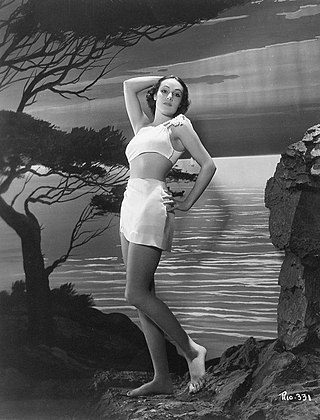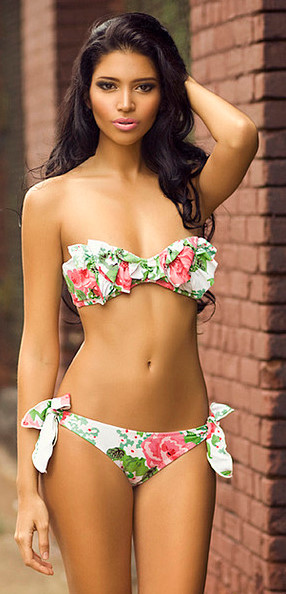A crop top (also half shirt, midriff top or cutoff shirt) is a top that reveals and exposes the waist, navel, or abdomen. [1]
Contents

A crop top (also half shirt, midriff top or cutoff shirt) is a top that reveals and exposes the waist, navel, or abdomen. [1]

The early history of the crop top intersects with cultural views towards the midriff, starting with the performance of Little Egypt at the 1893 Chicago World's Fair. [2] Although the crop top first gained prominence in the fashion industry during the 1930s [3] and 1940s [2] [4] [5] [6] —the latter in particular due to fabric rationing in World War II [7] —it was largely confined to women's underwear at the time. It was not until the sexual revolution of the late 1960s and early 1970s that it achieved widespread acceptance, [3] [2] worn by celebrities such as Barbara Eden (star of NBC's I Dream of Jeannie ) [8] and Jane Birkin. [9] [10] A variant style, the tied-up top or knotted shirt, [2] also appeared in 1940s fashion [11] and spread in popularity during the 1960s.
In the 1980s, cut-off crop tops became more common as part of the aerobics craze and as a result of the popularity of the movie Flashdance . Singer Madonna wore a mesh crop top in her music video for the song "Lucky Star". [12] In the 2010s, the crop top experienced a revival due to the popularity of 1990s fashion and they still remain popular in the 2020s. [13] [14] [15]
Crop tops have been worn by men [16] since the 1970s. [17] The early Rocky films have Sylvester Stallone and Carl Weathers wearing crop tops while working out. [18]
The protective gear of American football with no shirt resembles a crop top. Eventually cropped jerseys became available which carried over to several 1980s broadcasts. Men also started to wear crop tops regardless of sport. Acceptance for men wearing no shirt could be seen to eliminate the need for a crop top. Various crop tops have been worn by rappers as well as American football athletes. However, in 2015 the National Collegiate Athletic Association [19] [20] increased restrictions on men wearing crop tops, [21] [22] [23] [24] which also includes rolling up longer jerseys, giving no reason for the change. [25] [26] [27] [28]
Since the mid-2010s, the male crop top has seen a major resurgence in popularity, [29] including prominent celebrity figures such as football player Ezekiel Elliott, [30] rapper Kid Cudi, [31] rock star Josh Kiszka, and actors Matthew McConaughey and Zac Efron. [32]

A bikini is a two-piece swimsuit primarily worn by girls and women that features one piece on top that covers the breasts, and a second piece on the bottom: the front covering the pelvis but usually exposing the navel, and the back generally covering the intergluteal cleft and a little, some, or all of the buttocks. The size of the top and bottom can vary, from bikinis that offer full coverage of the breasts, pelvis, and buttocks, to more revealing designs with a thong or G-string bottom that covers only the mons pubis, but exposes the buttocks, and a top that covers only the areolae. Bikini bottoms covering about half the buttocks may be described as "Brazilian-cut".

A T-shirt is a style of fabric shirt named after the T shape of its body and sleeves. Traditionally, it has short sleeves and a round neckline, known as a crew neck, which lacks a collar. T-shirts are generally made of stretchy, light, and inexpensive fabric and are easy to clean. The T-shirt evolved from undergarments used in the 19th century and, in the mid-20th century, transitioned from undergarments to general-use casual clothing.

The navel is a protruding, flat, or hollowed area on the abdomen at the attachment site of the umbilical cord. All placental mammals have a navel, although it is generally more conspicuous in humans.

Hip-hop fashion refers to the various styles of dress that originated from Urban Black America and inner city youth in cities like New York City, Atlanta, and Los Angeles. Being a major part of hip hop culture, it further developed in other cities across the United States, with each contributing different elements to the overall style that is now recognized worldwide.

A blouse is a loose-fitting upper garment that may be worn by workmen, peasants, artists, women, and children. It is typically gathered at the waist or hips so that it hangs loosely ("blouses") over the wearer's body. Today, the word most commonly refers to a girl's or woman's dress shirt, although there is considerable confusion between a true blouse and a women's shirt. It can also refer to a man's shirt if it is a loose-fitting style, though it rarely is. Traditionally, the term has been used to refer to a shirt which blouses out or has an unmistakably feminine appearance, although even many "standard" shirts today have a somewhat blousy fit, and the numbers of men wearing such shirts may match that of women wearing actual blouses.

Leggings are several types of leg attire that have varied through the years. Modern usage from the 1960s onwards has come to refer to elastic close-fitting high-rise garments worn over the legs typically by women, such as leg warmers or tights. Usage from the 18th century refers to men's wear usually made of cloth or leather that is wrapped around the leg down to the ankle. In the 19th century, leggings usually referred to infants' leg clothing that were matched with a jacket, as well as leg-wrappings made of leather or wool and worn by soldiers and trappers. Leggings prominently returned to women's fashion in the 1960s, drawing from the form-fitting clothing of dancers. With the widespread adoption of the synthetic fibre Lycra and the rise in popularity of aerobics, leggings came to further prominence in the 1970s and 1980s, and eventually made their way into streetwear. Leggings are a part of the late 2010s into the 2020s athleisure fashion trend of wearing activewear outside sporting activities and in casual settings.

Casual wear is a Western dress code that is relaxed, occasional, spontaneous and suited for everyday use. Casual wear became popular in the Western world following the counterculture of the 1960s. When emphasising casual wear's comfort, it may be referred to as leisurewear or loungewear.

A sleeveless shirt is a shirt that is manufactured without sleeves or with sleeves that have been cut off. Depending on the style, they can be worn as undershirts, by athletes in sports such as track and field and triathlon, or as casual wear by both men and women.

Fashion in the 1990s was defined by a return to minimalist fashion, in contrast to the more elaborate and flashy trends of the 1980s. One notable shift was the mainstream adoption of tattoos, body piercings aside from ear piercing and, to a much lesser extent, other forms of body modification such as branding.

In team sports, the number, often referred to as the uniform number, squad number, jersey number, shirt number, sweater number, or similar is the number worn on a player's uniform, to identify and distinguish each player from others wearing the same or similar uniforms. The number is typically displayed on the rear of the jersey, often accompanied by the surname. Sometimes it is also displayed on the front and/or sleeves, or on the player's shorts or headgear. It is used to identify the player to officials, other players, official scorers, and spectators; in some sports, it is also indicative of the player's position.

In fashion, the midriff is the human abdomen. The midriff is exposed when wearing a crop top or some forms of swimwear or underwear.

The fashion of the 2000's is often described as a global mash up, where trends saw the fusion of vintage styles, global and ethnic clothing, as well as the fashions of numerous music-based subcultures. Hip-hop fashion generally was the most popular among young people of both sexes, followed by the retro inspired indie look later in the decade.

In association football, kit is the standard equipment and attire worn by players. The sport's rules specify the minimum kit which a player must use, and also prohibit the use of anything that is dangerous to either the player or another participant. Individual competitions may stipulate further restrictions, such as regulating the size of logos displayed on shirts and stating that, in the event of a match between teams with identical or similar colours, the away team must change to different coloured attire.
A cheerleading uniform is a standardized outfit worn by cheerleaders during games and other events. These uniforms typically include the official colors and mascots of the school or team and are designed to make the wearer appear physically attractive.

A bandeau is a garment comprising, in appearance, a strip of cloth. Today, the term frequently refers to a garment that wraps around a woman's breasts. It is usually part of a bikini in sports or swimwear. It is similar to a tube top, but narrower. It is usually strapless, sleeveless, and off the shoulder. Bandeaux are commonly made from elastic material to stop them from slipping down, or are tied or pinned at the back or front. In the first half of the 20th century, a "bandeau" was a narrow band worn by women to bind the hair, or as part of a headdress.

Low-rise is a style of clothing designed to sit low on, or below, the hips. The style can also be called lowcut, hipster, or hip-hugger. and can apply to garments worn by males or females. The term can be applied to all garments that cover the wearer's crotch area, including trousers, jeans, shorts, skirts, panties, briefs, bikinis, pantyhose, and tights.

Wearing underwear as outerwear is a fashion trend popularized by celebrities, sports and media. It began as a practical and comfortable variation of clothing, such as the T-shirt and the sleeveless shirt, but later evolved into provocative, controversial fashion statements. 21st century versions include the display of thongs and bras in women's clothing, and the display of underpants under low-slung pants in men. Wearing underwear as outerwear has historical antecedents in the display of undergarments in the sixteenth and seventeenth centuries.

The 2010s were defined by hipster fashion, athleisure, a revival of austerity-era period pieces and alternative fashions, swag-inspired outfits, 1980s-style neon streetwear, and unisex 1990s-style elements influenced by grunge and skater fashions. The later years of the decade witnessed the growing importance in the western world of social media influencers paid to promote fast fashion brands on Pinterest and Instagram.
Cultural views on the midriff and navel vary significantly. In some cultures the navel is seen as sexually and culturally significant, and its exposure has been subject to a variety of cultural norms and taboos, based on concepts of modesty. The views, customs and fashions relating to the midriff and navel change from time to time, and such exposure has become more widely acceptable, as reflected in the designs of clothing.

The fashions of the 2020s represent a departure from 2010s fashion and feature a nostalgia for older aesthetics. They have been largely inspired by styles of the late 1990s to mid-2000s, 1980s, and late 1960s to early 1970s Early in the decade, several publications noted the shortened trend and nostalgia cycle in 2020s fashion. Fashion was also shaped by the COVID-19 pandemic, which had a major impact on the fashion industry, and led to shifting retail and consumer trends.